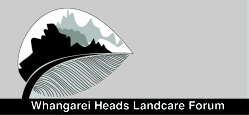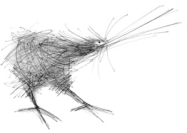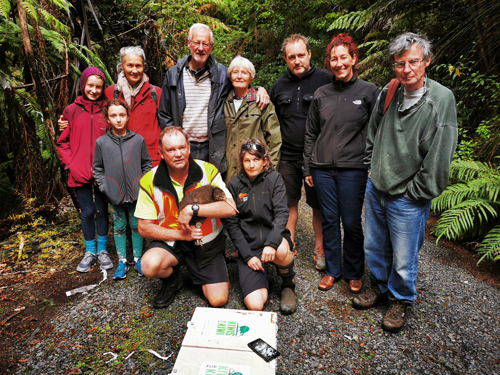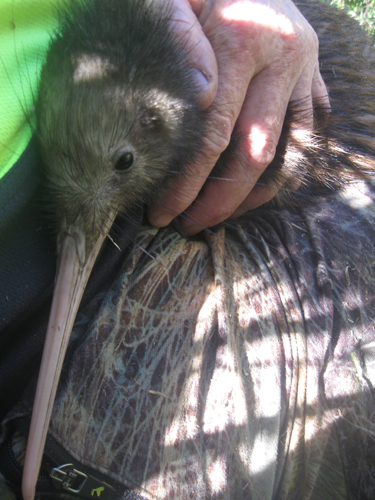2020 June Report
Whangarei Heads Landcare Forum AGM
Thanks to all those that made the AGM. Well done to our elected officers Chairperson – Danny Tuato’o, Secretary –Helen Moodie, Treasury- Audrey Rhodes and those on the committee. It was good to hear from the many Landcare groups working hard in the area and achieving great things.
Predator Free funding for possum eradication project
At the AGM Ripley Dean of the NRC outlined the proposed Predator Free Whangarei project and specifically the funding gained by the NRC from Predator Free for the attempted eradication of possums from the Whangarei Heads in the next 5 years. After discussion on this a further workshop was purposed and held. Thank you to those that attended that workshop last week and contributed their ideas and thoughts on the proposed eradication. The NRC are holding an open day at Mcleod Bay Hall on August 1 to discuss the project and answer questions – all are welcome to drop in to have input.
Kiwi Counting
The official kiwi counting period has finished and the hard working kiwi listeners are getting their 8 hours of listening data from each site into us for collating before Fay has the huge task of entering it all electronically. Despite the extremely dry conditions this year the counts are looking promising. I will let you know the final results once we have all the data sorted.
Backyard Kiwi Predator Control Program :
June catches: 1 stoat (another female), 4 weasels, 1 cat, 79 rats, 21 hedgehogs and 7 possums. I have changed over to eggs as the lure and stretched the round out to 5-6 weeks for the winter.
Provisional catch tallies for the 2019-2020 season are Stoats 28, weasels 30, cats 12, rats 800, hedgehogs 126 and possums 63. There will be some community trap numbers to add.
For what it is worth compared to the past 18 years trapping the stoat tally is the highest in 7 years, cats are way down (equal lowest year since 2002), rats are an all time record and possums are way down on past years. Trap catch data can be very misleading, especially for stoats and cats as it does not show the animals that we have been unable to catch or those controlled by toxin pulses. Far more important is the outcome monitoring ie how are the kiwi doing? And the increasing kiwi numbers show that our stoat control through trapping and controlled ground 1080 toxin pulses is working well!
Kiwi run over
Unfortunately an adult female kiwi was run over on a driveway in McLeod Bay last week. She was a healthy 2600g and was in good breeding condition. She had no transponder (the ID chip which we put in all the released kiwi and any of the young kiwi that we handle) so she was a wild hatched kiwi that had made it successfully to breeding age (thanks to stoat control). Kiwi rely heavily on their senses of smell and hearing so are not the best at dealing with fast moving cars so please keep an eye out for them. The breeding season seems to be a particularly dangerous time for them on the roads.
Kiwi Rescue from Motuora Island
You may have seen in the media the story of the kiwi on Motuora Island (a Doc kiwi crèche island in the Hauraki Gulf) where an increasing kiwi population and drought conditions has led to deaths there. Ayla from Doc Whangarei and Ngarie of Kiwi Coast organised a team of us to go to the island to catch kiwi and transfer them to kiwi recovery areas on the mainland so that those kiwi could recover and to take pressure off the remaining kiwi. 19 kiwi have now been transferred – 6 to the Marunui Conservation in the Brynderwyns and 11 to the Pukenui Western Hills to add to kiwi projects there. Last month I told you about “Beach Girl” who came to us after recovering with Robert Webb at the WNBRC. She has settled in at Taraunui Road extremely well and put on a massive 600g of weight in 15 nights feeding up and is now 2250g. On the weekend I also released “Ngaehe” in a similar area. Ngaehe is a young male that was too weak to be initially transferred so spent time recovering with the Moturoa ranger and then at the WNBRC. He is now a much better 1480g and feeding up in the wetlands at Tarauni Road. The last couple of months of rainfall have been great for kiwi everywhere in Northland.
What your radio tracked Backyard Kiwi have been up to:
The breeding season is running very late because of the previously dry conditions but some of the kiwi are showing signs of nesting.
Whangarei Heads Kiwi radio monitored kiwi:
Hancock – She has been moving between the top end of Kohinui Valley and Kerry Martin’s pines East of Owhiwa Road. Her nightly activity is 11.5 hours. Bill and I did her 6 monthly band change, she was 2500g and in good condition.
Whitu – Behind the freezing works at Reotahi, with the odd low activity night (6.5 hours) and an average of 8 hours so he may be starting to nest.
Pakipaki – In the pampas in the horse paddock at McLeod Bay, 12 hours activity. Did her transmitter change, she was 2400g and in poor-moderate condition and should now be putting more weight on.
EB – This guy has spent the last few years on Kerr Road and has proved tricky to catch for his transmitter change this year as he has been deep in the pampas. Kiwi transmitter bands are designed to wear out if we can’t catch up with the kiwi and this is what has happened with EB who dropped his transmitter this month. EB has been great at helping us let the dog owners of Kerr Road be aware of kiwi in their backyards and with good dog control he should have another 40-50 years there.
Ross – At the top end of Pepi road. Activity 12.5 hours. Did his annual transmitter change and he is a fat 2425g (very big for a boy) and hasn’t shown any sign of breeding. So to check if there are any girls nearby I put a Kiwi Listen Device (KLD) out. The data came back from the NRC showing only male calls with at least one other boy nearby. There are plenty of girls two valleys to the east, they must be just out of these boys’ hearing!
Teina – He is still well settled in the young pine block east of Owhiwa road, his nightly activity has gone back up to 11.5 hours.
Malaika – This young girl has stayed at Kerry Martin’s pine block for the past two months. Her nightly activity is 12 hours.
Harikoa – Still in the wetland at the NE end of Campbell road, 12.5 hours activity. Did her transmitter change, she was 2500g and in moderate-good condition.
Wally – In his usual area in the rushes on the Pataua estuary edge at the northern end of Campbell Road. 12 hours activity
Awhi – Still at the end of Campbell road down near the Pataua estuary. Her aactivity is 11 hours.
Rarewarewa/Purua kiwi: (for ONE program funded by Kiwis for kiwi)-
Thanks to Julia from Doc for monitoring these dads this month. Kimposter is nesting but other boys are still high activity.
Nick – 12 hours activity.
Sancho -11 hours activity.
Moeahu – 12 hours activity.
Kimposter – 9 hours activity. Pulse 48 and nesting 18 days as of 21/6/20.
Ngutu Roa – 13 hours activity .
Ngaro – 12.5 hours activity.
CT 07– 10.5 hours activity
Gorgeous – 11 hours activity.
Cheers Todd
Todd Hamilton
Backyard Kiwi Project Manager
Whangarei Heads Landcare Forum
















